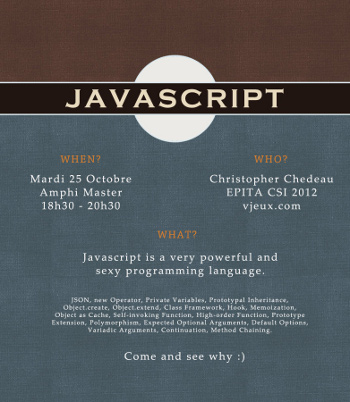For several months now I've been surveying my friends and teachers at EPITA and I came to the conclusion that they have absolutly no idea what Javascript really is. In order to help them discover a language that is getting a lot of traction nowadays, I'm organizing a 2-hour presentation on the subject.
If you know how to program and are interested in learning sexy advanced Javascript, you are more than welcome to attend this presentation. It will be Tuesday 25th October from 6:30pm to 8:30pm at EPITA Amphi Master (Metro Porte d'Italie). If you are in Paris at this time and speak French, do not hesitate to send me a mail at [email protected], I will explain how to get there 🙂
I've written a more lengthy explanation about my motives and presentation's content in the LRDE bulletin L'air de rien #23:

Edito par Olivier Ricou (Enseignant-Chercheur)
[...] Ce numéro est aussi l’occasion de mettre en valeur un étudiant du LRDE un peu fou, il aime Javascript, mais fort sympathique et qui sait partager sa passion. Il le fait à travers un article ici, mais aussi le mardi 25 octobre à 18h40 dans l’amphi masters (entrée libre). [...]
Présentation Javascript
Les sites tels que Gmail, Facebook et Google Maps sont des exemples classiques d'utilisation de Javascript. Mais saviez-vous que l'interface de Windows 8 ou les extensions de Chrome et Firefox sont écrites en Javascript? Ou qu'il est possible d'écrire des serveurs web en Javascript grâce à Node.js ?
Javascript est partout et pourtant, je me suis rendu compte en parlant autour de moi que personne ne connaissait réellement ce langage. C’est pourquoi je vous invite à une présentation de deux heures sur le sujet le Mardi 25 Octobre en Amphi Master de 18h40 à 20h40.
Javascript, le language
Pour commencer, un petit peu d'histoire. Brendan Eich raconte qu'il a pensé et implémenté le premier prototype de Javascript en 10 jours en 1995. En effet, Javascript est un langage qui contient un nombre extrêmement restreint de concepts. Cette idée provient du monde des langages fonctionnels tels que Lisp, Haskell ou Caml. Le génie de Javascript c'est d'avoir su s'écarter d'un modèle mathématique parfait au profit d'un confort d'utilisation pour le développeur.
Javascript a pour objectif d'être utilisé par le plus grand nombre de personnes. La syntaxe du langage a été fortement inspirée du C et ne contient aucune fantaisie. Cela rend le code source lisible et compréhensible par n'importe quel informaticien. Le language a été conçu pour exécuter un maximum de programmes, même mal formés. Par exemple, une heuristique va rajouter des point-virgules manquant. Au final, la barrière d'entrée au Javascript est très faible.
Lambda Fonctions et Objects
Javascript tire sa puissance de deux concepts fondamentaux: les Lambda fonctions et les Objets. La présentation a pour objectif principal de vous apprendre à manipuler ces deux outils. En guise d'introduction au langage, je montrerais comment reproduire des paradigmes de programmation connus, en particulier la Programmation Orientée Objet.
Le navigateur est un environnement hostile. Dans un site cohabitent une multitude de modules Javascript développés par des personnes différentes. On peut citer le site lui-même, les publicités, les commentaires, les statistiques, le bouton "like", etc. Nous verrons brièvement l'utilité des objets et des fonctions pour se placer dans l'un des trois points de vue suivant : être un citoyen respectueux, fortifier son code contre les attaquants ou au contraire s'amuser avec le code des autres.
Un langage dynamique
A l'école nous avons principalement étudié des langages de programmation statiques comme le C, C++ et Caml. Javascript quant à lui fait parti de la catégorie des langages dynamiques comme le PHP, Ruby ou Python. Les fonctionnalités de ces derniers ont pour objectif de simplifier la vie du développeur en s'éloignant des contraintes de la machine ou des théories mathématiques de typage. De ce fait, les langages dynamiques sont de plus en plus utilisés.
Nous étudierons les changements apportés par cette nouvelle façon de penser. Par exemple, les chaînes de caractères sont utilisées de façon quasi systématique afin de faciliter le débuggage, les objets sont construits à la volée dans définir leur structure dans un fichier séparé pour gagner du temps, etc.
Qui suis-je ?
Cette présentation n'est pas le fruit du hasard. Je me suis longuement intéressé à Javascript et aux langages dynamiques durant ces dernières années.
Le traitement d'image est largement developpé en utilisant des langages statiques en raison de l'important besoin en performance. Mon sujet de recherche au LRDE est d'adapter des concepts dynamiques tels que les lambda fonctions ou chaînage de méthode aux problématiques de traitement d'image
Je travaille en parallèle des cours pour la société Curse qui réalise des sites internet pour les joueurs de jeux en ligne dont World of Warcraft. J'utilise au quotidien Javascript, Python et PHP. Mes découvertes sont mises en ligne sur un blog : http://vjeux.com/.
À Épita, j'ai pu utiliser un langage de programmation dynamique dès ma première année. Lua est intégré dans Fooo, un remake de Warcraft III, afin de permettre des interfaces de jeu facilement personnalisables.


